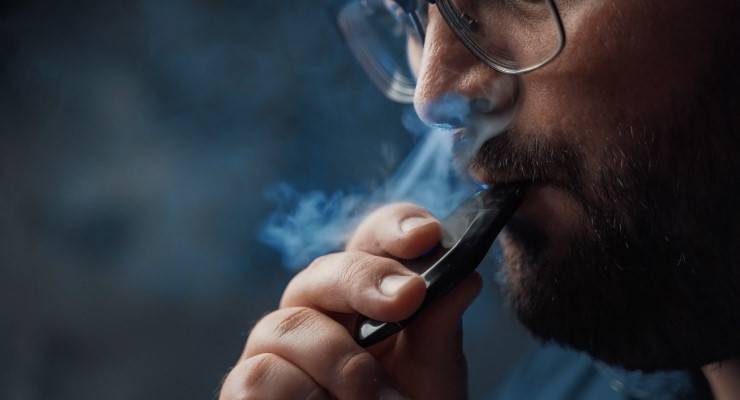
From tomorrow, it will be illegal to import e-cigarettes without a doctor’s prescription.
Australia’s laws on liquid nicotine products have been in the works for over a year. In December, the Therapeutic Goods Administration (TGA) listed liquid nicotine as a schedule 4 poison, but delayed implementing the import ban following backlash from lobbyists and politicians.
For the past nine months, retailers have exploited this loophole, with unregulated vapes readily available under the counter from many convenience and tobacco stores (though the Australian Association of Convenience Stores contests this claim).
Vape proponents say there’s no evidence of the dangers of vapes and that they may help smokers quit — while opponents say it’s leading a new generation to get hooked on nicotine.
The rise of vapes
Big tobacco has started marketing itself as a friend of public health, peddling smoke -free nicotine products as a less harmful alternative to cigarettes.
In January last year, the Royal Australian College of General Practitioners approved the use of nicotine for vaping for smokers have tried other methods and failed to quit. While there is some evidence e-cigarettes may help smokers cut back or even quit nicotine, there is limited clinical data — with some studies showing vapes may even hinder attempts to quit.
Tobacco companies have been accused of marketing brightly-coloured, fruit flavoured vapes to children, with one company even purchasing ads on teen-focused websites for Nickelodeon, Cartoon Network, and Seventeen magazine.
Between 2016 and 2019 there was up to a four-fold increase in e-cigarette usage between those aged 14 to 29. In NSW, some private schools have installed CCTV cameras to catch students vaping. From April 2020 to March this year, NSW has seized more than 51,000 illegal e-cigarettes.
The TGA has argued nicotine is highly addictive like heroin and cocaine, with international research funded by the World Health Organization finding an association between vaping among non-smokers and increased use of cigarettes later down the line.
Unregulated vapes have also been found to contain household disinfectants, petroleum, cosmetics, paint and other chemicals which may affect respiratory health. Lung injuries associated with vaping which emerged in 2019 were due to vitamin E acetate, an ingredient since removed in most vaping products.
What delayed the ban?
When Health Minister Greg Hunt announced the new nicotine restrictions in June last year, lobby groups were up in arms, with 28 Liberal and National MPs writing a letter condemning Hunt’s restrictions. The National Party is the only major political party in Australia still accepting donations from tobacco companies.
Some politicians have questioned the timing of the restrictions, arguing doctors should be focusing on administering COVID-19 vaccinations instead of nicotine prescriptions. Over 100,000 doctors are authorised to prescribe nicotine.
A petition has been also circulated around parliament arguing the ban persecutes the poor, the disabled and the pensioners of Australia who are addicted to nicotine but can’t afford cigarettes.
Others have said the laws show what a “nanny state” Australia is given the lack of long-term evidence of the dangers of vaping, pointing to New Zealand, which allows vape sales.
Is it too late?
The Australian Council on Smoking and Health chief executive Maurice Swanson tells Crikey the ban would “stop the illegal flow of disposable, highly addictive vaping products” sold to young people.
He said while the ban wasn’t too late, it would take some time to come into effect.
“Those addicted to nicotine would have stockpiled liquid nicotine products, but once those stockpiles have diminished they’ll have to go to their GP,” he said.
The prescription, which lasts 12 months with extensions available, will allow Australians to import nicotine of up to 100mg/mL concentration — more than five times the maximum allowed in Canada, the UK, and across the European Union.
“It will be critical for the TGA to monitor the impact and effectiveness of this nicotine prescription model and continue to ensure that children and young people are comprehensively protected from a lifetime of nicotine addiction,” Swanson said.








I’m baffled that cigarettes are legal while this is not. For one, vaping is much less harmful than smoking, so in terms of harm minimisation it would be a no
-brainer. But really it seems inconsistent – why should people be allowed to smoke but not vape for effectively the same product and dose?
This is moral panic at its finest. To quote Mrs Lovejoy – “Won’t somebody *please* think of the children?!”
Really, how would anyone know that it is “much less harmful”? There’s not been enough time to do enough research on vaping. The research that has been done indicates unexpected effects on wound healing in people’s mouths (it is extraordinarily delayed) and little-thus-far little-understood cellular reactions, particular to the heavy metals found during the vape process, and other, more mysterious effects on oral biofilm formation. No, it’s not ‘healthy – and what are kids vaping for anyway?
I remember seeing studies years ago where there were far fewer toxins and carcinogens – so vaping has less oh the things that we know casually are the problems with cigarettes. Even Johns Hopkins says this on their website.
“No, it’s not ‘healthy”
Who in their right mind would say it’s healthy??
I agree. Australians love a bit of moral panic. Particularly the bourgeoisie when in need of some easily obtained righteousness. I can right now go down the road and by a carton of cigarettes but can’t buy eliquid. That is insane. If you ban eliquid then it follows that you must ban tobacco. If you need a prescription for eliquid then you should need the same for cigarettes.
Were tobacco to be put up for introduction now it would not get to first base, based upon the many known harms
HArd to ban it now, not least because of the number of pollies on the payroll. Horse has bolted.
The harms were clearly evident to the industry in the 50’s and 60’s , also to medical researchers ( Doll et al. ) Industry spent decades denying the harms and paying politicians to do nothing, then argued against proper regulation etc etc. – a textbook case of very effective PR/Political guerilla warfare.
Why have more harm than we already have? The “think of the children” argument is not a Mrs Lovejoy argument. It is a recognition of the deliberate, systematic targeting of children by the industry so that they become lifetime addicts.
They have done this for years – remember Marlboro, also WInfield and Paul Hogan? Both were ciggies that the average 12yo could smoke without vomiting, but marketed with the”he man” image, so they took it up in droves. THis was no accident.
We are truly stuffed if we take out health prevention advice from the tobacco companies. If we do we will be having the same argument about vaping and its successor in another 50 years.
I don’t think anyone is going to the tobacco companies for health advice – there’s decades of suppression of science and a continuous misinformation campaign (as detailed in the book Merchants of Doubt).
The only reason to bring up the relative harm of vaping is the inconsistency between the justification of the ban (potential harm) and an equivalent product with a far greater track record for harm (cigarettes). If vaping is worse than cigarettes, then the case needs to be made with science. Otherwise it’s just another case of moral panic overriding being sensible.
If you believe that the tobacco companies are in this to reduce tobacco consumption by the young I have a slightly used harbour bridge going cheap.
They have known since the 60’s that their product kills 50% of its users. This is a problem as dead people can’t smoke, so have to be replaced. It is therefore necessary to recruit as many children and adolescents as possible, who will smoke for longer before they cark it.
They are funding various lobby groups, including doctors,, to push their “helps to quit “ line, for which there is some anecdotal evidence. The more worrying bit of the evidence is of the demonstration that vapers turn into smokers.
This is no doubt part of the plan
Your comments are absolutely ‘right on the mark’, Andrew. I am pleased to support you 110%!!
It’s a bizarre business plan ie: consumers are transformed into addicts who, mostly, become terminal & are no longer consumers. It’s akin to a restaurant very slowly poisoning its loyal diners.
The business model is that the diners are bled of money before they reel out the door to die. Their children and rellies are then invited to a free funeral reception at the restaurant
John Safran’s latest book Puff Piece is a pretty enjoyable read on all this sort of stuff.
Well I’ve vaped some DMT in the city a few times. Nothing like nicotine. Made me mentally laugh at the sheer ridiculousness that is the big lumbering machine called city life. This is what they are afraid of. You can put any drug into the vape. Weed, stims, even DMT. Haven’t heard anyone put opiates in but could happen.
Nicotine however remains the most addictive and this is the crux of the issue. Selling vapes as a cool thing for cool kids so the tobacco companies get their money back esp over plain packaging and what’s better than getting a whole bunch of kids addicted onto some weak stimmy drug that most of them can’t seem to get off.
And the government get their tax dollars
So that’s why a shopfront in Bay Street Port Melbourne has just opened as a ‘smoking’ shop, within the last 2 weeks….. was wondering……
28 Liberal and National MPs writing a letter condemning Hunt’s restrictions. The National Party is the only major political party in Australia still accepting donations from tobacco companies.
The Lucy brainchild to raise money to get her husband elected, the Wentworth Forum accepted money from British American Tobacco, I think that’s the company in which Cayman Mal and Lucy have shares.